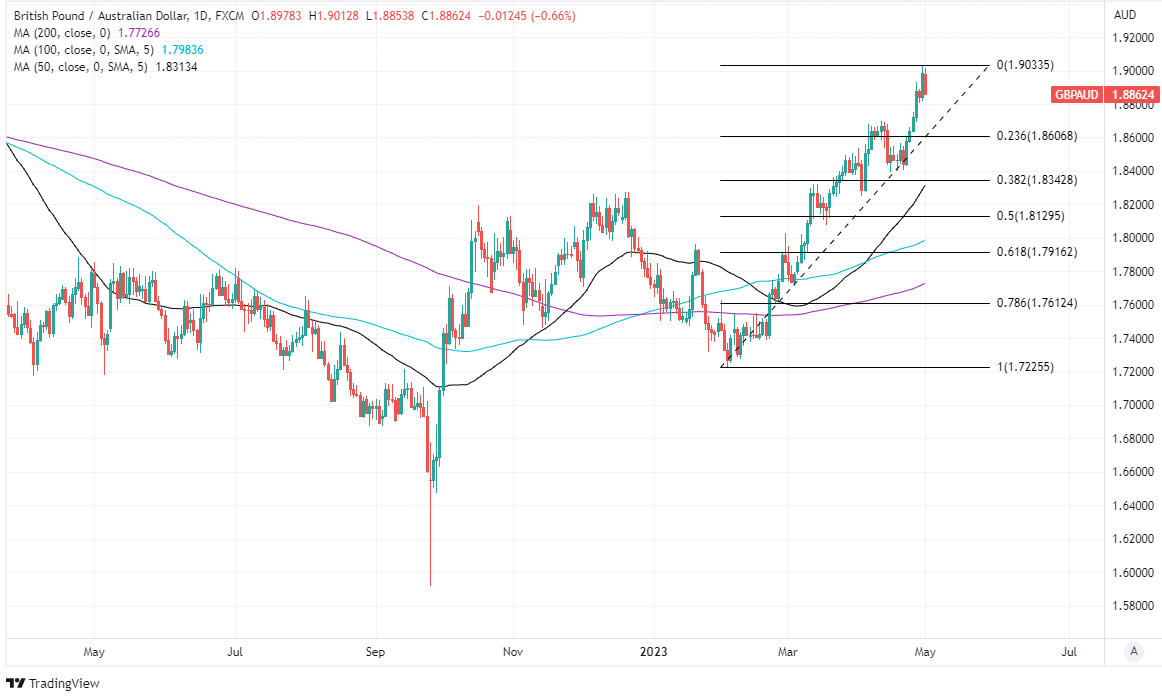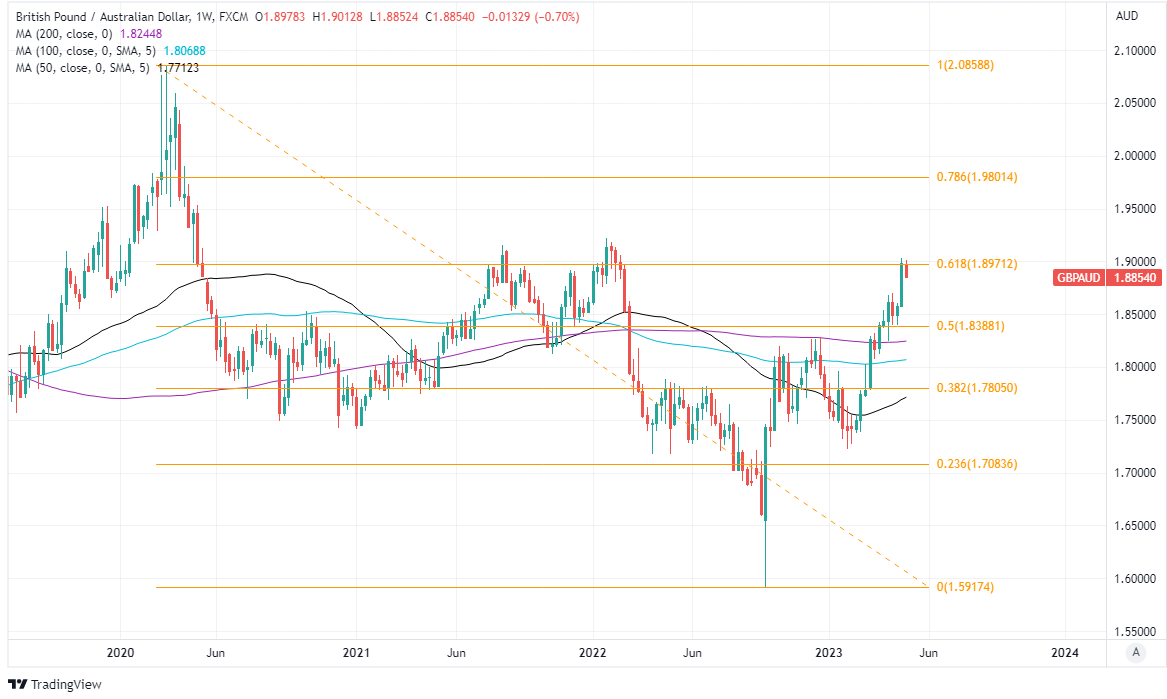GBP/AUD Week Ahead: Funder on Land Down Under Eyed
GBP/AUD rally stalled by major resistance near 1.8971
Scope for 1.8855 to 1.9085 range to confine short-term
Any surprise RBA rate rise could prompt sharp setback
Fed policy, U.S. data also a potential risk for GBP/AUD

Image © ArchivesACT, Reproduced under CC Licensing, Editorial, Non-Commercial
The Pound to Australian Dollar exchange rate has rallied to some of its best levels since the onset of the pandemic only to be obstructed by a major technical resistance overhead on the charts, which could now force Sterling to consolidate in a rough 1.8855 and 1.9085 range this week.
Australia's Dollar outperformed other major currencies in the opening session of the new week but remained a laggard for the recent month and year thus far with GBP/AUD having risen more than six percent over the latter period to reach its highest level since before the invasion of Ukraine.
GBP/AUD traded briefly above 1.90 last week for only the third time since the onset of the pandemic in what was a quiet period for UK economic newsflow but the outlook is now hinged on Tuesday's Reserve Bank of Australia (RBA) cash rate decision and a busy schedule of risk in the U.S.
"The RBA is viewed as looking for reasons to extend its pause, so an already wary market has trimmed pricing for a 2 May hike from a 25-30% chance to only about 10%," says Sean Callow, a senior FX strategist at Westpac in Sydney.
"Westpac has changed its call on the RBA’s likely decision this week. The RBA is not in a great hurry to return inflation to the 2-3% target band, only aiming for the top of the band by mid-2025," Callow writes in Monday market commentary.
 Above: Pound to Australian Dollar exchange rate shown at daily intervals with Fibonacci retracements of February rally and selected moving averages indicating possible areas of technical support. Click image for closer inspection.
Above: Pound to Australian Dollar exchange rate shown at daily intervals with Fibonacci retracements of February rally and selected moving averages indicating possible areas of technical support. Click image for closer inspection.
The combination of recent gains and overhead technical resistance leaves GBP/AUD vulnerable to a sharp corrective setback but if Westpac and financial markets are right in their thinking about the RBA cash rate outlook, then the catalyst for a correction might be unlikely to come from the land down under.
Westpac Economics had looked for the cash rate to be lifted from 3.6% to more than 4% in the opening half of the year but cut its forecasts and called time on the interest rate cycle this week when projecting that the RBA is now likely to be cutting its benchmark for borrowing costs by year-end.
"If our Australian economics team are correct, AUD/USD could lift by 0.8% (50bp) after the announcement based on historical responses to surprise interest rate hikes," says Kristina Clifton, a senior economist and currency strategist at Commonwealth Bank of Australia.
"Looking ahead, our Australian economics team expect the RBA to begin cutting the cash rate from November 2023 and have a steeper cutting cycle in their forecasts compared to current financial market pricing," Clifton adds.
Prices in interest rate derivative markets imply a high probability of the cash rate being left at 3.6% on Tuesday while economist forecasts suggest widespread agreement but Clifton and colleagues cite recent increases in population growth as one reason for why the RBA could surprise hawkishly.
Above: Quantitative model estimates of ranges for selected pairs this week. Source Pound Sterling Live. (If you are looking to protect or boost your international payment budget you could consider securing today's rate for use in the future, or set an order for your ideal rate when it is achieved, more information can be found here.)
GBP/AUD tends to be negatively correlated with AUD/USD and so would likely fall sharply on Tuesday if a surprise increase in the cash rate leads the latter to rally, though in the absence of that, third-party factors would likely do much of the leg work for Sterling and the Aussie this week.
These factors stem mainly from the U.S. where the greenback is likely to be responsive to the outcome of Wednesday's Federal Reserve (Fed) interest rate decision as well as the economic implications of Institute for Supply Management PMI surveys and the April non-farm payrolls report.
"We see some upside risk to the consensus view of 180k gain in April Nonfarm Payrolls. The Fed’s forecast of the unemployment rate implies it wants a much weaker outturn," says Tom Kenny, a senior economist at ANZ.
The Fed is widely expected to raise its interest rate to 5.25% on Wednesday but there may be an underappreciated risk of the bank leaving rates unchanged or otherwise signaling that it's unlikely to raise borrowing costs any further.
To the extent that Wednesday's Fed decision leads to profit-taking among U.S. Dollar buyers and holders, it could also act as a catalyst for a corrective setback in GBP/AUD, and likewise, if either of this week's economic numbers point further in the direction of a 'soft landing' for the U.S. economy.
 Above: Pound to Australian Dollar exchange rate shown at daily intervals with Fibonacci retracements of February rally and selected moving averages indicating possible areas of technical support. Click image for closer inspection.
Above: Pound to Australian Dollar exchange rate shown at daily intervals with Fibonacci retracements of February rally and selected moving averages indicating possible areas of technical support. Click image for closer inspection.
